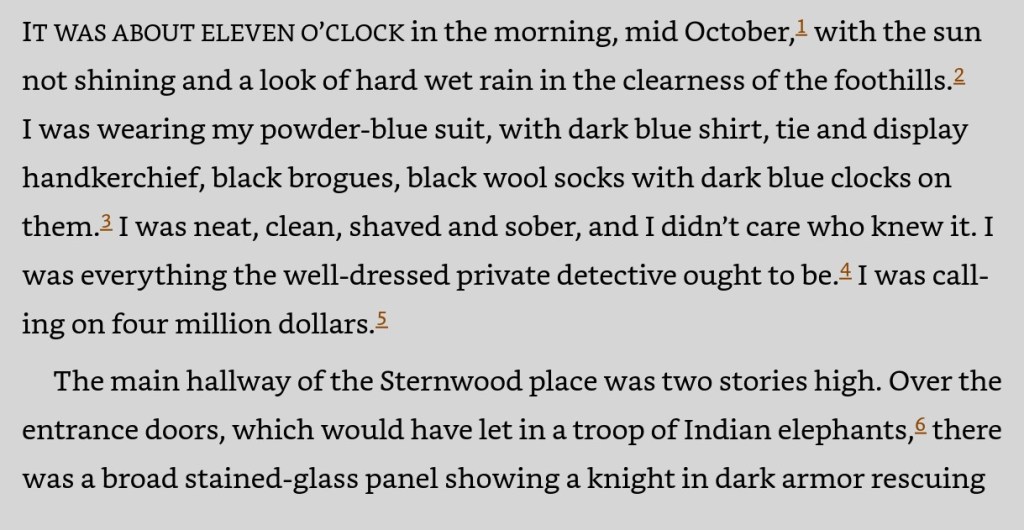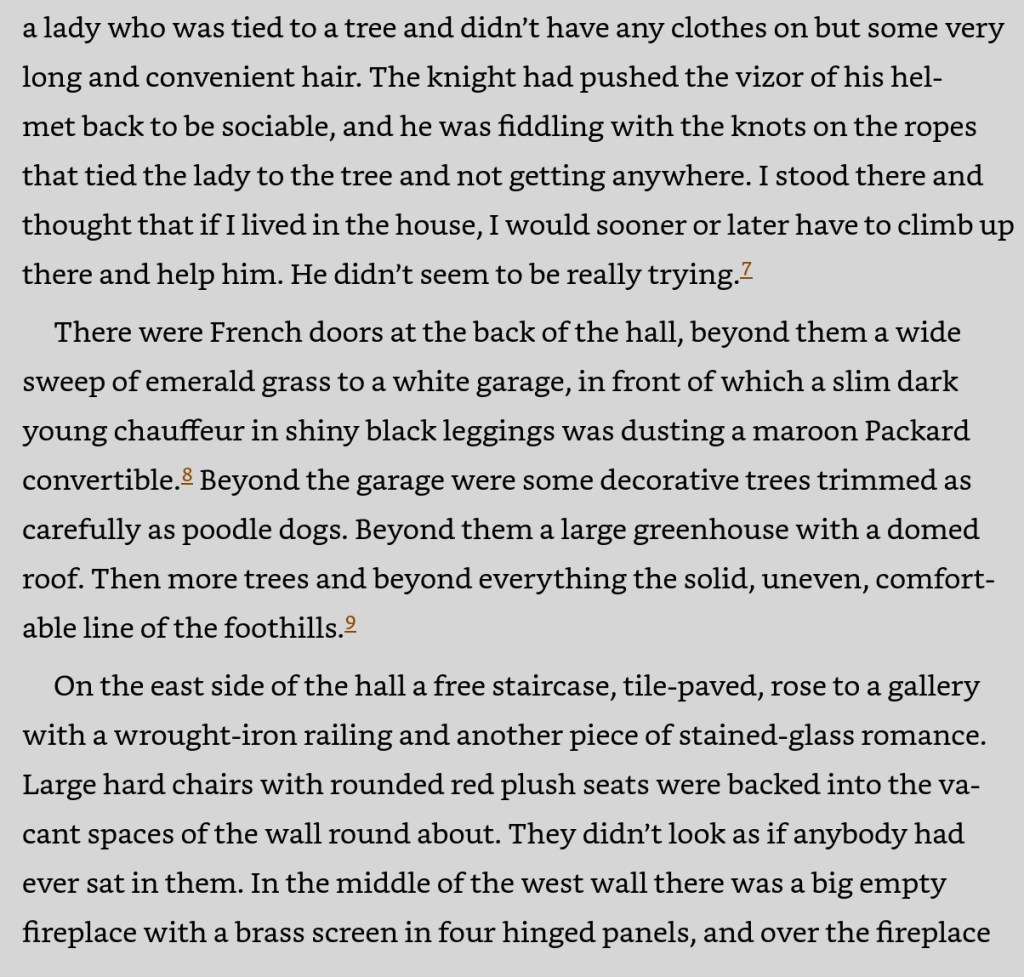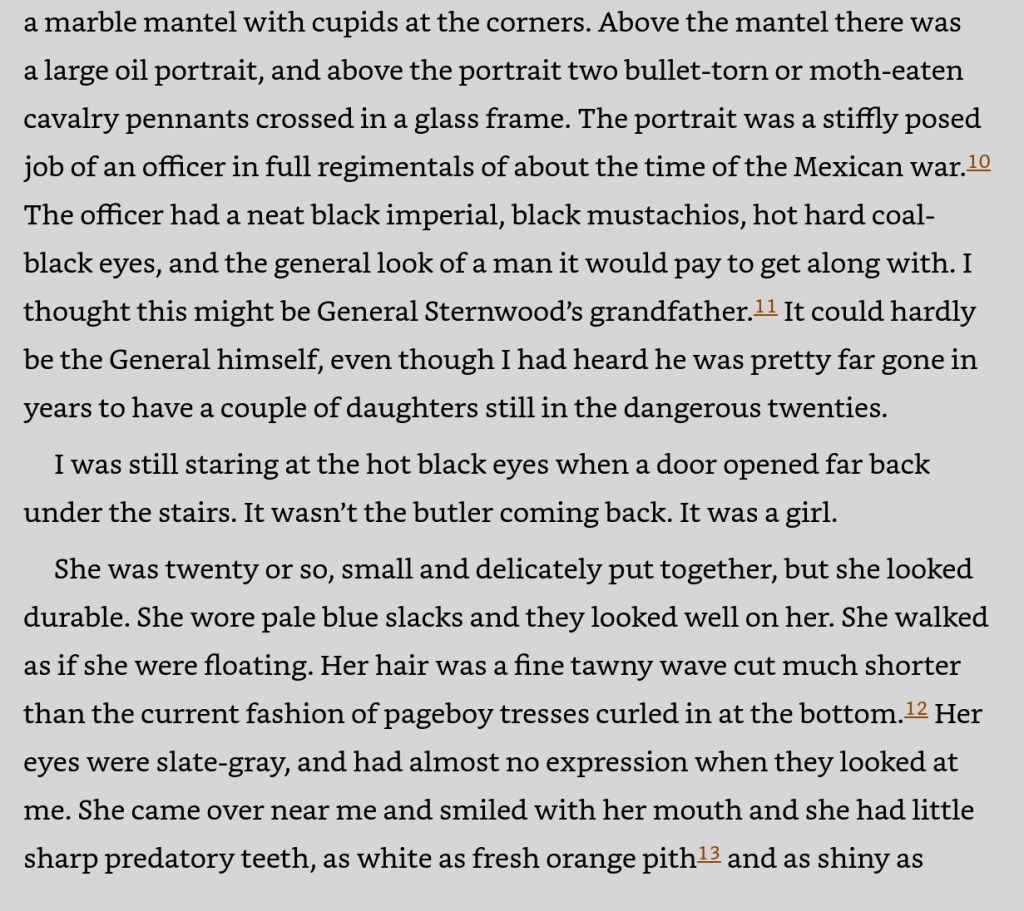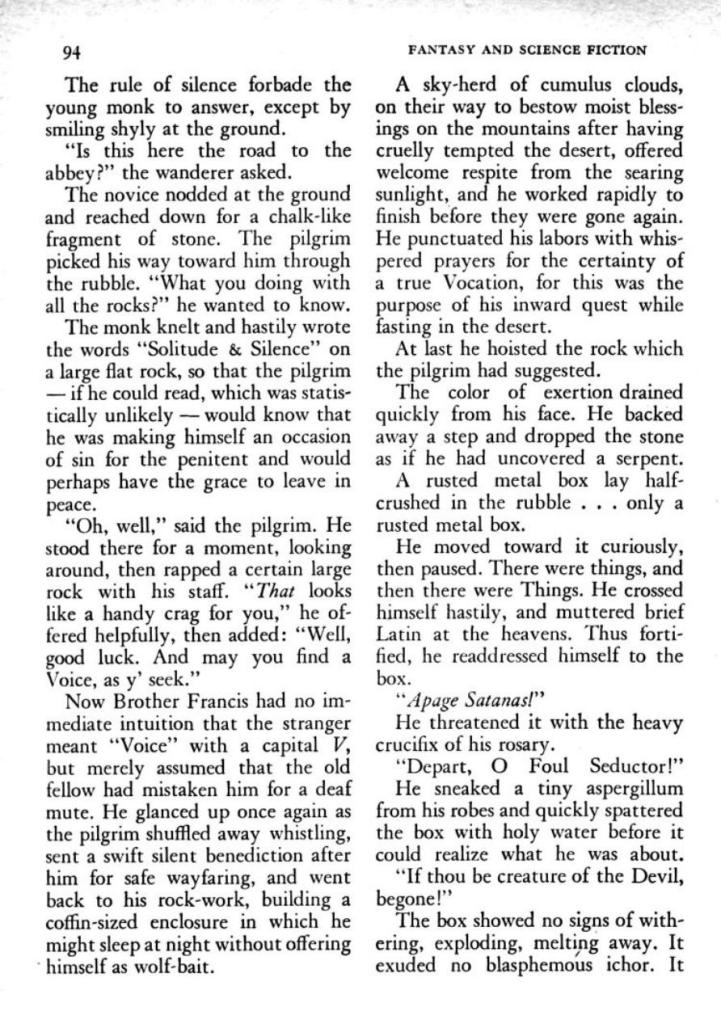I’m struggling to find a science fiction novel that grabs me. Months have passed since the last one I loved. That was The Hopkins Manuscript by R. C. Sherriff. It’s not that I don’t have hundreds of science fiction books waiting to be read, but finding one that profoundly resonates with my current mindset is difficult. I subsist on science-fiction short stories until a sci-fi Moby Dick breaks the waves of my attention.
I’ve mostly been diverting myself by reading nonfiction and novels from other genres. I just finished The High Window by Raymond Chandler and for whatever reason it did resonate perfectly with my current mood. I remember reading Farewell, My Lovely years ago and loving it. And I vaguely believe I read The Big Sleep, but that was long ago. Usually, I dislike mysteries, thrillers, and other crime novels. I just don’t care who did it.
What thrills me about Chandler’s books is his prose, and in particular, his descriptions. Chandler is famous for creating the detective, Philip Marlowe. Whenever pop culture satirizes the hardboiled detective, they are usually making fun of Marlowe’s way of talking. Chandler’s dialogue is painfully cliche. His convoluted plots often mystify and confuse. I would completely ignore Chandler if those two aspects were all he offered. What redeems Chandler in my eyes, even elevates him to a model writer, is his descriptions.
Wherever Philip Marlowe goes he describes what he sees in vivid detail. To illustrate my point, here are the first few pages of The Big Sleep. Last night I started watching the Humphrey Bogart version. I’ve seen it several times before. And after reading The High Window I decided to start over with Philip Marlowe and read his first appearance in a novel. When I went to buy it on Amazon I discovered The Annotated Big Sleep and it seemed perfect for jumping into the world of Raymond Chandler.




In the film it’s a bit different, the girl says, “You aren’t very tall” to Humphrey Bogart and he replies, “I try to be.” I’ve seen many different actors play Philip Marlowe and none of them matches my mind’s eye, but Bogie does okay. I watched a couple low budget versions of The High Window yesterday and was extremely disappointed. They go for Chandler’s cliche dialogue but they never capture the feel of the books. Even though Time to Kill (1942), The Brasher Doubloon (1947), and The Big Sleep (1946) were made in the 1940s, they don’t look like the 1940s Chandler describes. They only seem to be visual sketches or quick impressions.
Movies drive quickly through 1940s Los Angeles. Chandler strolls. He stops and smells the roses as well as the dog shit.
This got me thinking about science fiction. Are there any science fiction novels that paint the future in the same way that Chandler has portrayed the past? My first thought was of Dan Simmons’ Hyperion. I just went and checked, and it is indeed full of vivid details, but not at Chandler’s level of density. I’ve always liked Heinlein for his details, but checking shows he is a far cry from Chandler’s descriptions too.
Maybe it’s not possible to imagine the future in such detail. Hemingway steered writers away from such writing. But then, few writers like to go overboard on the details like Henry James or Edith Wharton. I guess what I like about Chandler is he paints realistic pictures with words while most modern writers have left realism for impressionism and minimalism or even the abstract.
I need to think about this. I need to pay closer attention to how science fiction writers describe the future. It occurs to me that Walter M. Miller, Jr. was quite vivid in the opening of “A Canticle for Leibowitz” in the April 1955 issue of F&SF.


If you know of science fiction novels that are rich in descriptive details, let me know in the comments.
James Wallace Harris, 4/20/23
Jim,
My thanks for once again putting out a coherent and damn interesting essay on a subject that of interest to me. I am a big Raymond Chandler fan, and have been for many decades. I agree with your thoughts about the vivid nature of his descriptions. The other factor that really comes to my mind is his success in evoking the Southern California sense of place that I know, or that I imagine would have applied there in that era. I believe he lived in LA and surrounding areas for a substantial time in his era, so that makes sense to me.
LikeLike
I liked “The Mountain in the Sea” by Ray Nayler a whole lot.
LikeLike
I did too.
LikeLike
I love time travel stories in which the reader gets to experience details of the setting (this applies to stories about time travel into the past).
But in Jack Finney’s Time and Again, there is so much detail about the New York of the 1880s that I actually got tired of it!
Stephen King does a good job in the early chapters of 11/22/63 (his best novel, imho), in which the protagonist convincingly describes the sights, sounds, and smells of the 1950s world in which he finds himself. It’s fantasy, though.
LikeLike
Yes, in Time and Again the details were very important. It even includes period photographs. I might try 11/22/63. I like books about the 1950s. I barely remember them, but I do remember them being very different. For one thing, I remember how stores and businesses did not have air conditioning and how they smelled. Houses didn’t have central air either. And offices would have windows that would open. I remember Woolworth stores and fountain Cokes.
LikeLike
I seriously loved 11/22/63, and of course it helps if you’re a Kennedy assassination nut. As always with King, the characters are three quarters of the show, and for once he doesn’t botch the ending. You may of course observe that the assassination wasn’t in the fifties—it was in 1963—but read it and see.
LikeLike
I think I will. You’ve convinced me.
LikeLike
Samuel Delany does. Nova, Triton, and Einstein Intersection are full of those kinds of details that make the world very real.
LikeLike
Jack Vance. Look at the first few pages of TO LIVE FOREVER a/k/a CLARGES.
LikeLike
I can’t recall To Live Forever. However, I was thinking about The Dying Earth or “The Moon Moth” as possible examples. I went and read about To Live Forever and it does sound interesting. I’m not well-read with Vance. My plan was to read Emphyrio as my next Vance book when I get the time.
I didn’t know how prolific a writer he was until I started watching the YouTube book reviewer Bookpilled. He’s always showing Vance books he’s bought or read. They seem endless.
LikeLike
EMPHYRIO is as good a book as Vance wrote and a fine place to go next. How descriptive it is, I don’t remember. Some of Vance’s work is more preoccupied with social structures and behavior than physical descriptions. Maybe his most intensely descriptive story is the ’50s short story “Noise,” which should not be too difficult to find via the usual indexes.
LikeLike
I also thought about Delany, but I haven’t read any of them lately. Last Sunday, I read “A Dog in a Fisherman’s Net.” I was impressed with the details in it. Our Facebook group has been reading Driftglass, one story every Sunday.
LikeLike
Strangely enough, last month I picked The High Window off of the bookshelf next to my reading chair and reread it. I followed it up this month with The Big Sleep. And I too was struck by the amount of description Chandler put into his stories, and in big chunks. I loved how he wasn’t afraid to describe an ugly room with an ugly sentence like this: “I went in. The room beyond was large and square and sunken and cool and had the restful atmosphere of a funeral chapel and something of the same smell.”
I think one difference between most SF and Chandler, was that Chandler was less concerned about the story or an idea. As he said himself; “I guess maybe there are two types of writers, writers who write stories and writers who write writing.” He considered himself one of the latter. I think he was playing with words and creating images, not illustrating abstract ideas. I know that after reading SF for a decade, discovering Chandler, and P. G. Wodehouse opened my eyes to the fact that you could enjoy the way a story was written independently of the plot, or indeed, regardless of plot.
LikeLike
I’ve been less concerned with plots. And I’ve also been getting into Wodehouse. We seem to have some reading overlap. I need to read more about Chandler.
LikeLike
I find that my favorite authors are English. Chandler, though an American, was educated in England and at the same school as Wodehouse, Dulwich. Perhaps it was how they were taught at school.
LikeLike
Maybe you’d be interested in what Chandler thought of SF. From a 1953 letter:
“Did you ever read what they call Science Fiction? It’s a scream. It’s written like this: ‘I checked out with K19 on Adabaran III, and stepped out through the crummaliote hatch on my 22 Model Sirus Hardtop. I cocked the timeprojector in secondary and waded through the bright blue manda grass. My breath froze into pink pretzels. I flicked on the heat bars and the Bryllis ran swiftly on five legs, using the other two to send out crylon vibrations. The pressure was almost unbearable, but I caught the range on my wrist computer through the transparent cysicites. I pressed the trigger. The thin violet glow was ice-cold against the rust-colored mountains. The Bryllis shrank to half an inch long and I worked fast stepping on them with the poltex. But it wasn’t enough. The sudden brightness swung me round and the Fourth Moon had already risen. I had exactly four seconds to hot up the disintegrator and Google had told me it wasn’t enough.’”
Quoted at https://chrisroutledge.co.uk/2006/06/28/raymond-chandler/
LikeLike
In short, he nailed it. But then, as a writer coming out of the pulps himself, he knew how to write’em.
LikeLike
That’s great. I should have wished that Raymond Chandler had written science fiction. His parody was wonderful. Chandler had an eye for visual details and an ear for words and phrasing.
Thanks again for that quote and link.
LikeLike